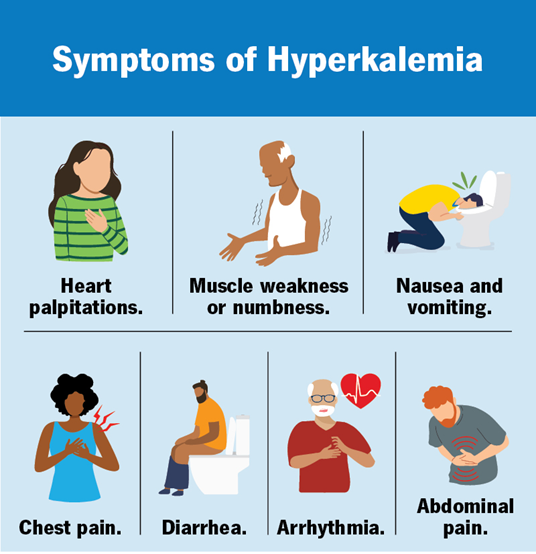The nurse is caring for a child with acute renal failure. Which clinical manifestation should the nurse recognize as a sign of hyperkalemia?
Cardiac arrhythmia
Seizure
Dyspnea
Oliguria
The Correct Answer is A
Choice A reason:
Cardiac arrhythmia is a primary clinical manifestation of hyperkalemia. Hyperkalemia, defined as an elevated level of potassium in the blood, can significantly affect the electrical activity of the heart. This can lead to various types of arrhythmias, including bradycardia, ventricular tachycardia, and even cardiac arrest1. The presence of arrhythmias is a critical indicator of hyperkalemia and requires immediate medical attention to prevent life-threatening complications.

Choice B reason:
Seizures are not typically associated with hyperkalemia2. While severe electrolyte imbalances can potentially lead to neurological symptoms, seizures are more commonly linked to conditions such as hyponatremia (low sodium levels) or hypocalcemia (low calcium levels). Therefore, seizures are not a primary sign of hyperkalemia.
Choice C reason:
Dyspnea, or difficulty breathing, can occur in various medical conditions, including heart failure and respiratory disorders. While hyperkalemia can lead to muscle weakness and fatigue, which might indirectly affect breathing, dyspnea is not a primary clinical manifestation of hyperkalemia. The main concern with hyperkalemia is its effect on cardiac function.
Choice D reason:
Oliguria, or reduced urine output, is a symptom of acute renal failure but not specifically indicative of hyperkalemia. While acute renal failure can lead to hyperkalemia due to the kidneys’ inability to excrete potassium, oliguria itself is not a direct sign of hyperkalemia. The focus should be on the cardiac effects of elevated potassium levels
Nursing Test Bank
Naxlex Comprehensive Predictor Exams
Related Questions
Correct Answer is D
Explanation
Choice A reason:
Offering peanut butter and water is not the best immediate action for treating hypoglycemia. Peanut butter is a protein-rich food that takes longer to digest and does not quickly raise blood sugar levels. Water does not contain any carbohydrates and will not help in raising blood sugar levels.
Choice B Reason:
Giving one tablespoon of ice cream is not the most effective way to treat hypoglycemia. While ice cream contains sugar, it also has fat, which slows down the absorption of sugar into the bloodstream. This delay can prevent the rapid correction of low blood sugar levels.
Choice C Reason:
Giving a hard candy lollipop to lick can provide some sugar, but it is not the most efficient method for quickly raising blood sugar levels. The amount of sugar in a lollipop may not be sufficient to correct hypoglycemia, and the slow consumption may delay the necessary rise in blood sugar.
Choice D Reason:
Providing 1/2 cup of juice followed by cheese with a cracker is the best action for treating hypoglycemia. Juice contains fast-acting carbohydrates that can quickly raise blood sugar levels. Following it with cheese and a cracker provides protein and fat, which help stabilize blood sugar levels and prevent them from dropping again.
Correct Answer is D
Explanation
The correct answer is d) Central nervous system.
Choice A reason:
The musculoskeletal system is not primarily affected by abnormal phenylalanine levels. Phenylketonuria (PKU) is a metabolic disorder that primarily impacts the brain and cognitive functions. While muscle weakness can occur due to overall health deterioration, it is not the primary system affected by phenylalanine toxicity.
Choice B reason:
The renal system is not the main target of phenylalanine toxicity. Although the kidneys play a role in filtering blood and excreting waste, the toxic effects of phenylalanine accumulation are more pronounced in the brain. Therefore, the renal system is not the primary system affected by abnormal phenylalanine levels.
Choice C reason:
The GI system, or gastrointestinal system, is not the primary system affected by abnormal phenylalanine levels. While dietary management is crucial for individuals with PKU to control phenylalanine intake, the toxic effects are primarily seen in the brain. The GI system is involved in the absorption and digestion of nutrients, but it is not the main system impacted by phenylalanine toxicity.
Choice D reason:
The central nervous system (CNS) is the primary system affected by abnormal phenylalanine levels. Phenylketonuria (PKU) leads to the accumulation of phenylalanine in the brain, causing severe brain damage and cognitive impairments. High levels of phenylalanine can disrupt neurotransmitter synthesis and brain development, leading to intellectual disabilities and other neurological issues. Therefore, the CNS is the main system impacted by phenylalanine toxicity.
Whether you are a student looking to ace your exams or a practicing nurse seeking to enhance your expertise , our nursing education contents will empower you with the confidence and competence to make a difference in the lives of patients and become a respected leader in the healthcare field.
Visit Naxlex, invest in your future and unlock endless possibilities with our unparalleled nursing education contents today
Report Wrong Answer on the Current Question
Do you disagree with the answer? If yes, what is your expected answer? Explain.
Kindly be descriptive with the issue you are facing.
